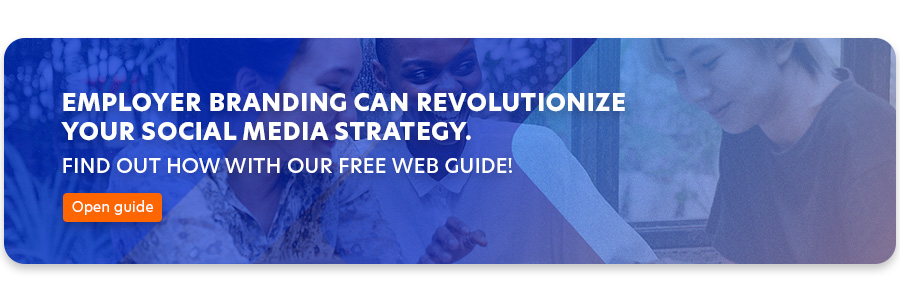When it comes to buzzword bingo for current trends, "employer branding" is definitely at the top of the list - but is this strategy rightly a household word?
We say yes, absolutely!
Given the shortage of skilled workers, employer branding can be a critical success factor for companies. Provided that it is implemented correctly! Read on to find out how it works and what else needs to be considered!
In a nutshell: What is employer branding?
It's not (really) that difficult to explain.
If you implement employer branding rigorously and successfully, your company gets a face. It gets a personality. It becomes clearly visible to the outside world what your company is all about, what values it represents, what culture it lives by, and what makes it different from other companies. And of course: why it is the absolute best place to work if you are currently looking for a new challenge, or why you as an employee should have no reason to look elsewhere.
Internal and external employer branding
In a world where talent and skills are becoming an increasingly scarce resource, employer branding has taken on enormous importance. It is no longer just about attracting and retaining candidates, but about enhancing the existing ones. Employer branding works internally to retain employees and externally to make the recruiting process more successful.
A strong, attractive employer brand helps attract the best talent, retain top employees, reduce recruiting costs and increase overall employee satisfaction.
It is a win-win-win - and a strategic investment in long-term competitiveness and business success.
When you take a strategic approach to recruiting, you are not only more likely to receive more applications, you are more likely to receive applications from the right candidates. Simply because your employer branding ensures that you are targeting the right people: Because they share the same values as the company, they are attracted to the culture, they want to help drive the vision, or because they have heard positive testimonials from existing employees. It is much clearer to see whether candidates are a good fit - and it works for both sides and pays off in the long run!
Key steps in developing an employer branding strategy
So far, so good.
But how do you create employer branding that is so successful that the positive effects mentioned above actually occur?
Step 1: Definition of the Employer Value Proposition
The Employer Value Proposition (EVP) is the (added) value that a company offers its employees as an employer in order to attract and retain them. The EVP answers the question of why talented people should work for the company. It includes salary, benefits, culture, career development, work-life balance and ethical values. This value proposition is the foundation of the employer branding strategy and should be included in all communications to candidates and employees.
The following questions can help you develop your EVP
- What is special about the company and what does it stand for?
- What is the company's vision and mission?
- What distinguishes the company as an employer?
- What are the reasons for choosing the company as an employer?
- What does the company offer current employees?
- How can these points be differentiated from the competition?
Step 2: Define communication channels
The work done in step 1 is worthwhile if it finds its way "out there". This applies to both internal and external communication. This requires a detailed knowledge of your target group (in this case, potential and existing employees).
The various points of contact need to be defined and appropriate content created. Typically, these include the company's website, intranet, social media, newsletters, appropriate brand ambassadors (corporate influencers), events, and career fairs.
Step 3: Define communication content
Once the core of the corporate brand is in place and the communication channels have been defined, the next step is to develop the specific content that will be communicated externally and internally.
This includes employer branding materials that can be displayed and distributed at trade shows or events, articles for trade publications, social media posts, and content for newsletters and the website. A good place to start is with a (graphic) representation of the company's values and vision, an overview of the benefits of being an employee, and a glimpse into the company's culture.
Your own employees offer testimonials: The best social proof for all of these topics is real employee testimonials in the form of short video or written interviews. Whether for magazines, social media, or as an article on your own website: Nothing is more honest or authentic. Employees can talk about their day-to-day work, give their perspective on why they like working at the company, talk about their career path so far, or share their favorite social events and other benefits.
Step 4: Find and retain the right people
This step is about making the previous work slowly but surely pay off! Employer branding activities are integrated into the recruiting strategy and are often the first point of contact with the company for potential employees - they find exciting and meaningful content through the various communication channels, feel addressed by the corporate vision and share similar values. As a result, you are much more likely to attract and retain the right people.
Important for existing employees: Make sure that the values and promises you talk about are actually lived! Engage employees, keep them excited about their work, and give them the opportunity to contribute to employer branding as corporate influencers to inspire others.
5 ways to embed the employer branding strategy in your organization
1. Model the company values:
Your company values are like the heartbeat of your organization. Once established, they need to be actively lived and made visible. It is not enough to put them on a poster on the wall. They must be actively lived and implemented in everything you do. Your employees should not only know them, they should feel them.When they experience this in their daily work, it creates a strong bond!
Tips for this are:
- Use clear language: short, concise, and easy to understand.
- Communicate regularly: Share the values continuously and openly in meetings, trainings and events.
- Leaders as role models: Leaders must model the values so that employees can be guided by them.
- Reward and recognize: Implement systems that reward employees for living the values.
- Corporate social responsibility: The company should engage in social and environmental initiatives that are consistent with the values.
2. Involve all levels
Employer branding is not just a task for the HR department. Everyone in the company has a role to play in strengthening the employer brand. Managers should act as role models and actively live the values. Employees at all levels should have the opportunity to contribute ideas and feedback. Use surveys to give all levels the opportunity to contribute and provide feedback on whether the values are still relevant.
3. Create a positive work environment
A great employer brand starts with creating a great place to work. Make sure your employees feel comfortable and valued. This doesn't just mean a fancy office complex, but a culture of respect and appreciation.
Even the "fruit basket" as a great benefit is no longer a decisive argument, but a matter of course. So what else does the company offer to make life easier for employees? These include home office options, flexible working hours, flat hierarchies and creative freedom. Team-building events also fall into this category, creating a stronger bond between employees and the company.
4. Provide development opportunities
Employees want to grow. Give them the opportunity to do so! This can be done through training, education, or mentoring programs. Show that you are interested in their long-term career. Some companies reimburse employees for books that help them learn, or offer interdisciplinary work groups to expose employees to new areas of expertise and provide new challenges.
5. Diversity and Inclusion
Promote a diverse and inclusive work environment that welcomes people regardless of gender, race, or background. Candidates: Candidates with diverse backgrounds and experiences often seek employers that value their diversity and foster business innovation through multiple perspectives. In addition, the company demonstrates that it operates in an ethical and socially responsible manner and fosters an open, inclusive culture.
Concluding the employer branding strategy
Last but not least, it should be emphasized (and this is nothing new, but still not to be underestimated) that employer branding is not a one-time project, but an ongoing process. You have to keep at it, be flexible and constantly check whether your measures are working. The result pays off and is the valuable cornerstone of an employer brand that magically attracts the right (!) talent and inspires your own employees every day.
Especially if social media is an important part of your employer branding strategy - and where is it not? It makes sense to take a closer look at the underlying processes. How can you increase the efficiency of posting, replying and reporting? Especially in the area of employer branding, where the task is often shared between marketing and HR, the use of social media management tools like Facelift can be useful. Are you curious about how Facelift can help you? Then ask for a free demo.








